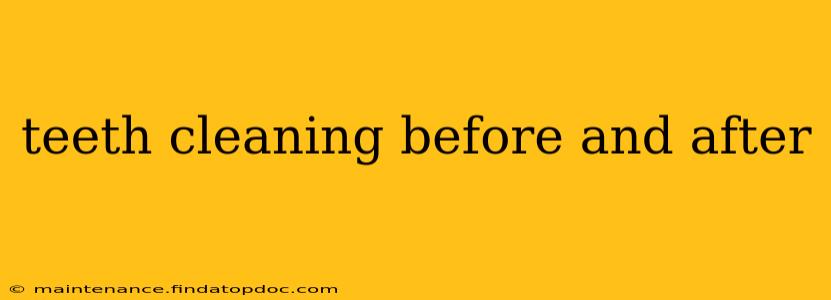Maintaining optimal oral hygiene is crucial for overall health. Regular brushing and flossing are essential, but professional teeth cleaning takes oral care to the next level. This comprehensive guide explores the process of professional teeth cleaning, from the before to the after, addressing common questions and concerns.
What Happens Before a Professional Teeth Cleaning?
Before your appointment, your dentist or hygienist will likely ask about your medical history, including any medications you're taking and any allergies you have. It's important to be completely honest and transparent about your health status to ensure your safety and the effectiveness of the procedure. They may also inquire about your oral hygiene routine and any concerns you have about your teeth or gums.
What should I do to prepare for my teeth cleaning?
Preparing for your cleaning is simple but crucial. Brush and floss thoroughly the morning of your appointment. Avoid sugary drinks and foods immediately beforehand, as this can affect the accuracy of certain assessments. If you have any anxieties about the procedure, communicate this to your dental professional; they can help alleviate your concerns.
What Happens During a Professional Teeth Cleaning?
A professional teeth cleaning, also known as a prophylaxis, typically involves several steps:
-
Examination: The dentist or hygienist will begin by examining your teeth and gums to check for any signs of decay, gum disease, or other oral health issues. X-rays might be taken to assess the underlying health of your teeth and jawbone.
-
Scaling and Root Planing (if necessary): This is the core of the cleaning process. Scaling removes plaque and tartar (calculus) from above and below the gum line. Root planing smooths the tooth roots to prevent further buildup. This might be slightly uncomfortable, but the hygienist will take steps to minimize any discomfort.
-
Polishing: After scaling and root planing (if applicable), the teeth are polished to remove surface stains and leave them feeling smooth. This step contributes significantly to the "after" feeling of clean, gleaming teeth.
-
Fluoride Treatment (often): A fluoride treatment is usually applied to strengthen tooth enamel and prevent cavities. This is a crucial step in preventative dentistry.
Does it hurt to get my teeth cleaned?
Most people find professional teeth cleaning to be relatively painless. While some discomfort might occur during scaling and root planing, particularly if you have gum disease, modern techniques and the use of local anesthetics minimize any pain. The hygienist will always prioritize your comfort.
What to Expect After a Professional Teeth Cleaning?
After your cleaning, you'll likely notice a significant difference in the feel and appearance of your teeth. Your teeth will feel noticeably cleaner and smoother.
What should I avoid after my teeth cleaning?
For a short period after your cleaning, it's best to avoid staining foods and drinks like coffee, tea, red wine, and brightly colored sauces. Your teeth are more susceptible to staining immediately following the polishing process.
How Often Should I Get My Teeth Cleaned?
Most dental professionals recommend getting your teeth cleaned professionally every six months. However, this can vary depending on your individual oral health needs and risk factors. Your dentist will advise you on the appropriate frequency for your specific circumstances.
How much does a teeth cleaning cost?
The cost of a professional teeth cleaning varies depending on your location, the dental practice, and the extent of the cleaning required. It's best to contact your dental office to inquire about their pricing.
How long do the effects of a teeth cleaning last?
The benefits of a professional teeth cleaning are not permanent. Consistent daily brushing and flossing, along with regular check-ups, are essential to maintaining the improved oral health achieved through professional cleaning. The polished and clean feeling will fade gradually as plaque and tartar begin to accumulate again.
By understanding the process of professional teeth cleaning, from the preparation and procedure to the aftercare and maintenance, you can take an active role in maintaining a healthy and beautiful smile. Remember, regular check-ups and professional cleanings are key to preventing dental problems and preserving your oral health for years to come.
